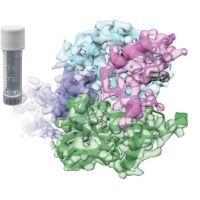Specification
| Description | Recombinant protein from the full-length sequence of homo sapiens secreted frizzled related protein 2 (SFRP2) (NM_003013). |
| Organism | Homo sapiens (Human) |
| Expression Host | Human Cells |
| Tag Info | His or DYKDDDDK. Please contact us if you need further information or require specific designed tag. |
| Purity | Greater than 90% by SDS-PAGE gel |
| Uniprot ID | Q96HF1 |
| Entry Name | SFRP2_HUMAN |
| Gene Names | SFRP2 FRP2 SARP1 FKSG12 UNQ361/PRO697 |
| Alternative Gene Names | FRP2 SARP1 |
| Alternative Protein Names | Secreted frizzled-related protein 2 (FRP-2) (sFRP-2) (Secreted apoptosis-related protein 1) (SARP-1) |
| Application | Antigens, Western, ELISA and other in vitro binding or in vivo functional assays, and protein-protein interaction studies; For research & development use only! |
| Buffer | Purified protein formulated in a sterile solution of PBS buffer, pH7.2, without any preservatives |
| Endotoxin | Endotoxin level is < 0.1 ng/µg of protein (<1EU /µg) |
| Length | 295 |
| Molecular Weight(Da) | 33490 |
| Protein Sequence | (The sequence of expressed protein may have some variation from the sequence shown below. Please contact us for the exact sequence.) MLQGPGSLLLLFLASHCCLGSARGLFLFGQPDFSYKRSNCKPIPANLQLCHGIEYQNMRLPNLLGHETMKEVLEQAGAWIPLVMKQCHPDTKKFLCSLFAPVCLDDLDETIQPCHSLCVQVKDRCAPVMSAFGFPWPDMLECDRFPQDNDLCIPLASSDHLLPATEEAPKVCEACKNKNDDDNDIMETLCKNDFALKIKVKEITYINRDTKIILETKSKTIYKLNGVSERDLKKSVLWLKDSLQCTCEEMNDINAPYLVMGQKQGGELVITSVKRWQKGQREFKRISRSIRKLQC |
Background
| Function | FUNCTION: Soluble frizzled-related proteins (sFRPS) function as modulators of Wnt signaling through direct interaction with Wnts. They have a role in regulating cell growth and differentiation in specific cell types. SFRP2 may be important for eye retinal development and for myogenesis. |
| Pathway | |
| Protein Families | Secreted frizzled-related protein (sFRP) family |
| Tissue Specificity | Expressed in adipose tissue, heart, brain, skeletal muscle, pancreas, thymus, prostate, testis, ovary, small intestine and colon. Highest levels in adipose tissue, small intestine and colon. {ECO:0000269|PubMed:9391078, ECO:0000269|PubMed:9642118}. |
QC Data
| Note | Please contact us for QC Data |
| Product Image (Reference Only) |  |

